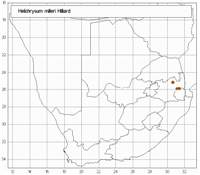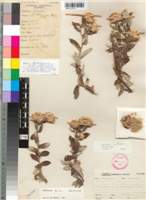Origin of name:
milleri is named after Oliphant Bell Miller (1882�1966), a Scot who worked in South Africa and Zimbabwe.
Diagnostic characters:
Large solitary headsBrown bracts
Description:
Shrub up to 1 m tall, branches brittle, glandular-setose, thinly white-woolly as well when young, wool often persisting under the heads, leafy. Leaves mostly (15�) 20�25 x 6�12 mm, oblong or oblong-lanceolate, obtuse to acute, apiculate, base broad, half-clasping, both surfaces greyish-white woolly, wool persistent on sterile twigs, shed on flowering twigs to reveal the glandular-setose surface. Heads heterogamous, c. 15 mm long, c. 32 mm across the radiating bracts, depressed-globose, solitary or few at the tips of the lateral flowering twigs. Involucral bracts in c. 9 series, graded, imbricate, much exceeding the flowers, glossy, light brown. Receptacle shortly honeycombed. Flowers c. 600�700, 30�60 female, 570�650 homogamous. Achenes 1.25 mm long, glabrous. Pappus bristles equaling corolla, tip barbellate, shaft scabrid, base smooth.
Flowering in October and November.
Distribution:
Probably always in coarse herbage on the margins of forest patches. Recorded only from the Barberton Mountains, at Havelock and Emlembe Mountain on the Swaziland-Mpumalanga border, and from the Lydenburg area.
Grassland and Savanna Biomes.
Notes:
H. milleri is unusual in this group in its spring flowering. It is easily recognized by its leaves that remain persistently grey-woolly on the sterile twigs but on the flowering twigs gradually shed the wool to reveal the green and glandular-setose surfaces, brown heads solitary or few at the tips of the lateral flowering twigs, and pappus bristles without patent cilia at the base.Taxonomy:
Literature:
Helichrysum milleri Hilliard in Notes R. bot. Gdn Edinb. 40: 259 (1982).
Type:
Mpumalanga, Barberton distr., Emlembe Mountain, Devil's Bridge, 5 200 ft. 26 x 1963, Miller 8509 (PRE, holo.).
Synonym(s):
Vouchers:
Anderson A80 (PRE); Miller 3035 (PRE).
